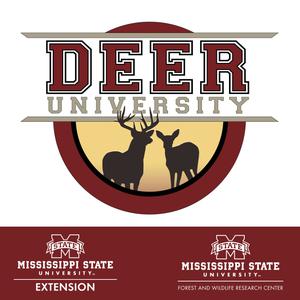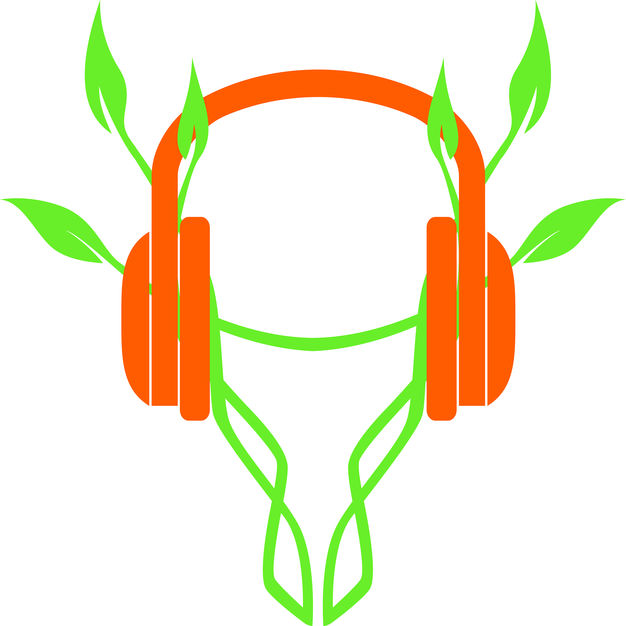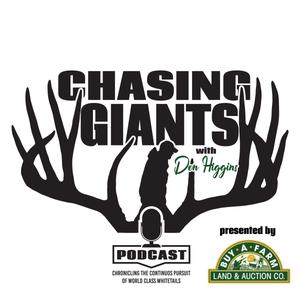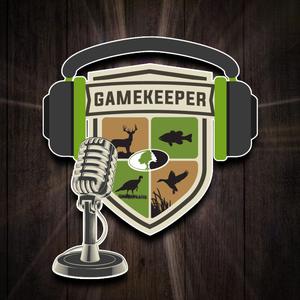
Deer University
Dr. Bronson Strickland & Dr. Steve Demarais
- 1 hour 59 minutesEpisode 081 - Lunar Table Fables - Does the Moon Affect Buck Activiy?
Natasha Neary, Luke Resop, Steve Demarais, and Bronson Strickland delve into the relationships between moon phases, positions, and their potential effects on buck movement and bedding behavior. They review their research findings from a complex and exhaustive analysis of GPS-collared bucks to determine if moon phase and/or position has any relationship with buck movement behaviors. They emphasize the importance of accounting for individual buck personalities and behaviors during the rut and highlight the challenges in drawing definitive conclusions. The discussion also includes insights from a survey of hunters to gauge beliefs and expectations of the moon’s role in stimulating buck movement, and the implications of various lunar theories. The conversation highlights the complexity of deer behavior and the importance of data-driven insights to understand these patterns.
Check out the MSU Deer Lab’s online seminar series (here) and choose the Natural Resources option from the Categories drop down menu. You will have to create an account to view the seminars. The seminars are free unless you are seeking professional educational credits.
Also, be sure to visit our YouTube channel (here)
15 November 2024, 9:00 pm - 41 minutes 43 secondsEpisode 080 - Buck Antler Size and Landscape Context
In this third episode with Dr. Mark Turner, we discuss Mark's research exploring the factors that contribute to the variation in population-level buck antler size. He explains that deer tend to be larger in areas further north due to heat retention and dissipation. He also highlights the importance of landscape characteristics, such as row crop agriculture, in influencing deer size. Additionally, he emphasizes the significance of managing forage availability on individual properties, including improving early successional plant communities and implementing holistic food plotting approaches. Overall, the key takeaways are the importance of considering the context of a property within the larger landscape, the potential for incremental improvements in deer management, and the need to manage both habitat and deer density to optimize deer quality.
Check out the MSU Deer Lab’s online seminar series (here) and choose the Natural Resources option from the Categories drop down menu. You will have to create an account to view the seminars. The seminars are free unless you are seeking professional educational credits.
Also, be sure to visit our YouTube channel (here)
Takeaways
Deer tend to be larger in areas further north due to heat retention and dissipation.
Row crop agriculture and early successional plant communities are positively associated with deer size.
Managing forage availability on individual properties can lead to significant improvements in deer quality.
Improving early successional plant communities and implementing holistic food plotting approaches are effective strategies for increasing forage availability.
Managing both habitat and deer density is crucial for optimizing deer quality.
20 September 2024, 8:54 pm - 38 minutes 55 secondsEpisode 079 - Estimating nutrient requirements for deer
In this episode, Dr. Mark Turner discusses his research on the nutrient requirements of deer and the availability of native plants to fulfill those requirements. He sampled common deer forages throughout the Eastern US and found that only 44% of the forages sampled met the minimum crude protein requirement, and only 19% met the minimum phosphorus requirement. This highlights the importance of providing a diverse range of forage options for deer. Mark also emphasizes the need to consider both the amount and quality of forage when estimating nutritional carrying capacity. He suggests that landowners consider incorporating native plants into their management strategies and diversify their food plots to provide a more balanced diet for deer. And Steve may have rambled a little too.
Takeaways
Providing a diverse range of forage options is important for meeting the nutrient requirements of deer.
Only 44% of the forages sampled met the minimum crude protein requirement, and only 19% met the minimum phosphorus requirement.
Estimating nutritional carrying capacity requires considering both the amount and quality of forage available.
Incorporating native plants into management strategies can help provide a more balanced diet for deer.
Diversifying food plots can also contribute to meeting the nutritional needs of deer.
Sound Bites
"Diversify your habitat and then let them do their job"
"Deer have pretty high phosphorus requirements and a lot of the plants are not meeting that requirement"
"Deer develop an aversion to forages that are very high in nutrients they already have"
Check out the MSU Deer Lab’s online seminar series (here) and choose the Natural Resources option from the Categories drop down menu. You will have to create an account to view the seminars. The seminars are free unless you are seeking professional educational credits.
Also, be sure to visit our YouTube channel (here)
23 August 2024, 9:00 pm - 41 minutes 42 secondsEpisode 078 – Predicting Antler Size from Doe Body Weight
In this conversation, Bronson, Steve, and Mark Turner discuss the relationship between doe body weight and buck antler size. Mark's research at the University of Tennessee aimed to evaluate how deer body and antler size varied across the eastern US and what habitat characteristics were associated with bigger deer. The results showed a consistent relationship between doe body weight and buck antler size, with an 8.5-inch increase in antler size for every 10-pound increase in doe body mass. This relationship provides a predictive equation that can help property managers and hunters assess and improve buck antler size by focusing on increasing doe body weight. The conversation also includes topics like harvest bias, compositional bias, and monitoring techniques.
Check out the MSU Deer Lab’s online seminar series (here) and choose the Natural Resources option from the Categories drop down menu. You will have to create an account to view the seminars. The seminars are free unless you are seeking professional educational credits.
Also, be sure to visit our YouTube channel (here)
Takeaways:
There is a consistent relationship between doe body weight and adult buck antler size, with an 8.5-inch increase in antler size for every 10-pound increase in doe body weight.
Increasing doe body weight can lead to larger buck antler size, providing a predictive equation for property managers and hunters to assess and improve antler size.
Harvest bias and compositional bias can affect the accuracy of data collected on deer populations, and monitoring techniques should account for these biases.
Understanding the relationship between doe body weight and buck antler size can help property managers and hunters make informed decisions about deer management and habitat improvement.
Further research is needed to explore the variation in doe body weight and antler size across different regions and climates.
Sound Bites:
"If you can produce 120-inch does, your average mature male is gonna be 139 inches."
"When you give them food and manage the habitat, doe body weights respond, bucks respond, antlers respond."
"If you're not seeing the size of deer that you think you should be seeing, it may be that pulling the trigger is the issue."
30 July 2024, 8:22 pm - 54 minutes 44 secondsEpisode 077 - Your Summer To-Do List
In this conversation, Bronson and Steve discuss various topics related to deer management during the summertime. They start by addressing recent concerns about hunters contracting CJD (Creutzfeldt-Jakob disease) from consuming deer with CWD and emphasize the importance of following public health guidelines and not eating venison from CWD-positive deer. They then move on to discuss deer management tasks for the summer, including getting soil tests and adjusting pH for food plots, moving hunting blinds off food plots to reduce disturbance, controlling ryegrass in food plots, and using prescribed fire for habitat management. They highlight the benefits of burning during the growing season and the importance of providing high-quality forage for deer. Bronson and Steve emphasize the importance of analyzing harvest data and deer observations to make informed decisions about deer population and harvest strategies. Additionally, they discuss the benefits of forest management, improving road access, and diversifying food sources. The conversation concludes with a reminder to start planning larger-scale projects, such as timber harvest, well in advance.
Check out the MSU Deer Lab’s online seminar series (here) and choose the Natural Resources option from the Categories drop down menu. You will have to create an account to view the seminars. The seminars are free unless you are seeking professional educational credits.
Also, be sure to visit our YouTube channel (here)
22 May 2024, 9:52 pm - 1 hour 12 minutesEpisode 076 - Buck Food Plot Use During the Hunting Season
In this episode we visit with Dr. Natasha Ellison to review her findings relative to buck use of food plots during the hunting season. How often are bucks visiting food plots pre-rut, peak-rut, and post-rut? When are bucks spending more time on food plots? How does hunting pressure affect these relationships? Natasha is a Mathematical Ecologist and is helping the MSU Deer Lab dig deeper in the buck movement dataset to answer questions about buck behavior relevant to hunters and managers.
Check out the MSU Deer Lab’s online seminar series (here) and choose the Natural Resources option from the Categories drop down menu. You will have to create an account to view the seminars. The seminars are free unless you are seeking professional educational credits.
Also, be sure to visit our YouTube channel (here)
10 April 2024, 8:11 pm - 1 hour 19 minutesEpisode 075 - Pulling the Covers Off Buck Beds
In this episode we visit with Luke Resop to discuss buck beds and bedding areas. How often are they bedding? What’s their affinity to certain bedding areas? What’s the circuit time for returning to a bedding area? Day beds and night beds are all discussed. We also introduce our newest member to the MSU Deer Lab, Dr. Natasha Ellison. She is a Mathematical Ecologist and is helping us dig deeper in the buck movement dataset to answer questions about buck behavior relevant to hunters and managers.
Check out the MSU Deer Lab’s online seminar series (here) and choose the Natural Resources option from the Categories drop down menu. You will have to create an account to view the seminars. The seminars are free unless you are seeking professional educational credits.
Also, be sure to visit our YouTube channel (here)
13 March 2024, 8:54 pm - 54 minutes 2 secondsEpisode 074 – Understanding Buck Movement – Part 2
The latest Extension publication from the MSU Deer Lab is “Understanding Buck Movement: How, When, and Why Bucks Navigate the Landscape” is now available for viewing and download. You can find the publication here:
https://www.msudeer.msstate.edu/results.php?q=deer%20movement
In Part 2, Steve and Bronson discuss more of the findings presented in the publication and explain how you can interpret the data and use the information for management and hunting.
Check out the MSU Deer Lab’s online seminar series (here) and choose the Natural Resources option from the Categories drop down menu. You will have to create an account to view the seminars. The seminars are free unless you are seeking professional educational credits.
Also, be sure to visit our YouTube channel (here)
12 January 2024, 2:28 am - 1 hour 17 minutesEpisode 073 – Understanding Buck Movement – Part 1
The latest Extension publication from the MSU Deer Lab is “Understanding Buck Movement: How, When, and Why Bucks Navigate the Landscape” is now available for viewing and download. You can find the publication here:
https://www.msudeer.msstate.edu/results.php?q=deer%20movement
In Part 1, Steve and Bronson discuss some of the findings presented in the publication and explain how you can interpret the data and use the information for management and hunting.
Check out the MSU Deer Lab’s online seminar series (here) and choose the Natural Resources option from the Categories drop down menu. You will have to create an account to view the seminars. The seminars are free unless you are seeking professional educational credits.
Also, be sure to visit our YouTube channel (here)
19 December 2023, 10:44 pm - 41 minutes 20 secondsEpisode 072 – Fall food plots, how late is too late?
The Deep South and other parts of the whitetail’s range are experiencing severe drought and many cool-season food plots are struggling or failing. In this episode we visit with Dr. Erick Larson, an Agronomist and Extension Specialist at Mississippi State University, that works with many of the forages hunters and managers plant for deer. Erick will discuss when is too late and what steps we can take to make the best of a bad situation.
Check out the MSU Deer Lab’s online seminar series (here) and choose the Natural Resources option from the Categories drop down menu. You will have to create an account to view the seminars. The seminars are free unless you are seeking professional educational credits.
Also, be sure to visit our YouTube channel (here)
13 November 2023, 3:11 pm - 1 hour 7 minutesEpisode 071 - Rubs and Scrapes with Karl Miller
What is a deer signpost? In this episode Steve and Bronson visit with Dr. Karl Miller, the former professor and researcher of deer biology and management at the University of Georgia. Karl and his students and colleagues have studied white-tailed deer signposting behavior for decades and he shares key findings regarding the biology and ecology of this research, and how you can apply it to hunting.
Check out the MSU Deer Lab’s online seminar series (here) and choose the Natural Resources option from the Categories drop down menu. You will have to create an account to view the seminars. The seminars are free unless you are seeking professional educational credits.
Also, be sure to visit our YouTube channel (here)
12 September 2023, 2:27 pm - More Episodes? Get the App
Your feedback is valuable to us. Should you encounter any bugs, glitches, lack of functionality or other problems, please email us on [email protected] or join Moon.FM Telegram Group where you can talk directly to the dev team who are happy to answer any queries.
 Habitat Podcast
Habitat Podcast
 Land & Legacy - Sportsmen's Nation
Land & Legacy - Sportsmen's Nation
 Chasing Giants with Don Higgins
Chasing Giants with Don Higgins
 Fist Full of Dirt
Fist Full of Dirt
 Gamekeeper Podcast
Gamekeeper Podcast